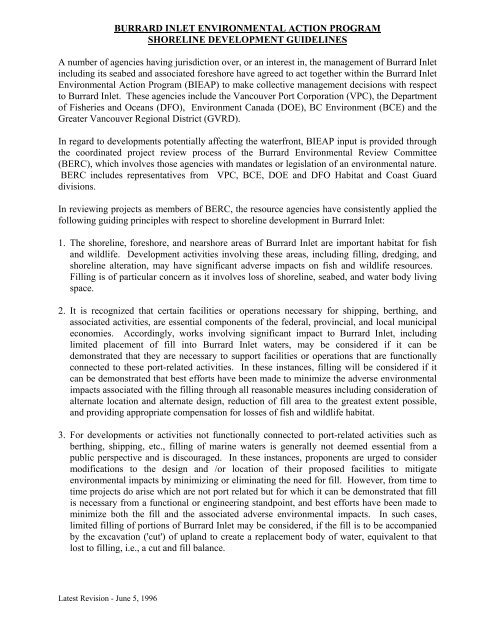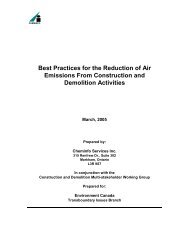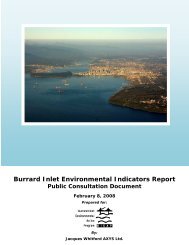burrard inlet environmental action program - the BIEAP and FREMP ...
burrard inlet environmental action program - the BIEAP and FREMP ...
burrard inlet environmental action program - the BIEAP and FREMP ...
You also want an ePaper? Increase the reach of your titles
YUMPU automatically turns print PDFs into web optimized ePapers that Google loves.
Latest Revision - June 5, 1996<br />
BURRARD INLET ENVIRONMENTAL ACTION PROGRAM<br />
SHORELINE DEVELOPMENT GUIDELINES<br />
A number of agencies having jurisdiction over, or an interest in, <strong>the</strong> management of Burrard Inlet<br />
including its seabed <strong>and</strong> associated foreshore have agreed to act toge<strong>the</strong>r within <strong>the</strong> Burrard Inlet<br />
Environmental Action Program (<strong>BIEAP</strong>) to make collective management decisions with respect<br />
to Burrard Inlet. These agencies include <strong>the</strong> Vancouver Port Corporation (VPC), <strong>the</strong> Department<br />
of Fisheries <strong>and</strong> Oceans (DFO), Environment Canada (DOE), BC Environment (BCE) <strong>and</strong> <strong>the</strong><br />
Greater Vancouver Regional District (GVRD).<br />
In regard to developments potentially affecting <strong>the</strong> waterfront, <strong>BIEAP</strong> input is provided through<br />
<strong>the</strong> coordinated project review process of <strong>the</strong> Burrard Environmental Review Committee<br />
(BERC), which involves those agencies with m<strong>and</strong>ates or legislation of an <strong>environmental</strong> nature.<br />
BERC includes representatives from VPC, BCE, DOE <strong>and</strong> DFO Habitat <strong>and</strong> Coast Guard<br />
divisions.<br />
In reviewing projects as members of BERC, <strong>the</strong> resource agencies have consistently applied <strong>the</strong><br />
following guiding principles with respect to shoreline development in Burrard Inlet:<br />
1. The shoreline, foreshore, <strong>and</strong> nearshore areas of Burrard Inlet are important habitat for fish<br />
<strong>and</strong> wildlife. Development activities involving <strong>the</strong>se areas, including filling, dredging, <strong>and</strong><br />
shoreline alteration, may have significant adverse impacts on fish <strong>and</strong> wildlife resources.<br />
Filling is of particular concern as it involves loss of shoreline, seabed, <strong>and</strong> water body living<br />
space.<br />
2. It is recognized that certain facilities or operations necessary for shipping, berthing, <strong>and</strong><br />
associated activities, are essential components of <strong>the</strong> federal, provincial, <strong>and</strong> local municipal<br />
economies. Accordingly, works involving significant impact to Burrard Inlet, including<br />
limited placement of fill into Burrard Inlet waters, may be considered if it can be<br />
demonstrated that <strong>the</strong>y are necessary to support facilities or operations that are functionally<br />
connected to <strong>the</strong>se port-related activities. In <strong>the</strong>se instances, filling will be considered if it<br />
can be demonstrated that best efforts have been made to minimize <strong>the</strong> adverse <strong>environmental</strong><br />
impacts associated with <strong>the</strong> filling through all reasonable measures including consideration of<br />
alternate location <strong>and</strong> alternate design, reduction of fill area to <strong>the</strong> greatest extent possible,<br />
<strong>and</strong> providing appropriate compensation for losses of fish <strong>and</strong> wildlife habitat.<br />
3. For developments or activities not functionally connected to port-related activities such as<br />
berthing, shipping, etc., filling of marine waters is generally not deemed essential from a<br />
public perspective <strong>and</strong> is discouraged. In <strong>the</strong>se instances, proponents are urged to consider<br />
modifications to <strong>the</strong> design <strong>and</strong> /or location of <strong>the</strong>ir proposed facilities to mitigate<br />
<strong>environmental</strong> impacts by minimizing or eliminating <strong>the</strong> need for fill. However, from time to<br />
time projects do arise which are not port related but for which it can be demonstrated that fill<br />
is necessary from a functional or engineering st<strong>and</strong>point, <strong>and</strong> best efforts have been made to<br />
minimize both <strong>the</strong> fill <strong>and</strong> <strong>the</strong> associated adverse <strong>environmental</strong> impacts. In such cases,<br />
limited filling of portions of Burrard Inlet may be considered, if <strong>the</strong> fill is to be accompanied<br />
by <strong>the</strong> excavation ('cut') of upl<strong>and</strong> to create a replacement body of water, equivalent to that<br />
lost to filling, i.e., a cut <strong>and</strong> fill balance.
<strong>BIEAP</strong> - Shoreline Development Guidelines<br />
Page 2 of 4<br />
These guiding principles should be considered by all parties proposing to undertake projects<br />
which may involve works within or adjacent to <strong>the</strong> waters <strong>and</strong> foreshore of Burrard Inlet. It is<br />
important to identify, at <strong>the</strong> earliest stage possible, port <strong>and</strong> non-port related activities associated<br />
with <strong>the</strong> project <strong>and</strong> to determine <strong>the</strong> locations, functional interrelationships, <strong>and</strong> areal extent of<br />
each, as <strong>the</strong>y relate to any proposed filling of Burrard Inlet. The amount of shoreline alteration<br />
or new water coverage to which consideration will be given by <strong>the</strong> BERC member agencies will<br />
depend on <strong>the</strong> ability of <strong>the</strong> proponent to design in accordance with <strong>the</strong> guiding principles stated<br />
above.<br />
<strong>BIEAP</strong> member agencies remain available for fur<strong>the</strong>r discussion of <strong>the</strong>se principles <strong>and</strong> <strong>the</strong>ir<br />
implications to <strong>the</strong> location <strong>and</strong> technical design of any proposed development. However to<br />
assist proponents with <strong>the</strong>ir consideration of <strong>the</strong>se principles with respect to conceptual designs,<br />
<strong>the</strong> following guidelines are presented:<br />
• Fill should only be considered for specific elements of a project that can be demonstrated<br />
to be functionally connected to port-related facilities or operations. Fill may also be<br />
considered where necessary to ensure appropriate habitat compensation. For o<strong>the</strong>r<br />
aspects of a project, proponents should consider upl<strong>and</strong> located, pile supported or floating<br />
structures wherever possible.<br />
• Fill proposed for aspects of <strong>the</strong> project not functionally port-related, if allowed, will likely<br />
be subject to <strong>the</strong> creation of a replacement body of water through excavation of an<br />
equivalent area of upl<strong>and</strong>, i.e., a cut <strong>and</strong> fill balance must be maintained in relation to <strong>the</strong><br />
water body.<br />
• In keeping with <strong>the</strong> foregoing point, alternatives to filling should be considered for public<br />
open spaces, including park or public walkway features. In this regard, municipalities may<br />
have significant requirements for park <strong>and</strong> public open space in connection with shoreline<br />
developments. Any fill for <strong>the</strong>se purposes, if allowed, will likely be subject to an<br />
equivalent excavation of upl<strong>and</strong> to ensure a cut <strong>and</strong> fill balance.<br />
• There should not be any reduction in <strong>the</strong> overall length of <strong>the</strong> shoreline. Where fill is<br />
proposed, it should be designed such that <strong>the</strong>re will be a significant increase in <strong>the</strong><br />
shoreline length in order to compensate for loss of sea bed <strong>and</strong> water column associated<br />
with <strong>the</strong> filling.<br />
• New shoreline should be designed to provide optimum conditions for colonization by local<br />
marine organisms <strong>and</strong> <strong>the</strong> establishment <strong>and</strong> growth of healthy <strong>and</strong> diverse marine<br />
communities. To this end, consideration should be given to factors such as slope stability<br />
<strong>and</strong> grade, suitability of materials to support marine growth, exposure to sunlight <strong>and</strong><br />
shading, tidal elevation.<br />
• Shoreline created as compensation for lost habitat should be designed for maximum<br />
production <strong>and</strong> habitat value. Features <strong>and</strong> areas designed specifically as optimum habitat<br />
Latest Revision - June 5, 1996
<strong>BIEAP</strong> - Shoreline Development Guidelines<br />
Page 3 of 4<br />
should be incorporated into <strong>the</strong> shoreline wherever possible. Features should include<br />
gentle slopes (minimum 2:1 horizontal:vertical) faced with suitable materials, <strong>and</strong> benches<br />
or berms incorporated into <strong>the</strong> shoreline at appropriate tidal elevations. Alternative<br />
designs which may offer creative solutions to incorporating habitat features into <strong>the</strong><br />
shoreline should be pursued. Solid vertical faces (i.e. caissons, bulkheads, etc.) will not be<br />
suitable for habitat compensation.<br />
• Proposals for dredging should take into account existing habitat values <strong>and</strong> adverse<br />
impacts that might result from proposed dredging.<br />
Once <strong>the</strong> guiding principles have been applied to project design, consideration can be given to<br />
site specific measures <strong>and</strong> design details that will fur<strong>the</strong>r mitigate impacts on habitat, <strong>and</strong>, where<br />
applicable, appropriate measures to compensate for habitat losses. To allow for productive<br />
discussion of <strong>the</strong>se <strong>and</strong> related matters, <strong>and</strong> to enable BERC to properly assess <strong>the</strong> potential<br />
<strong>environmental</strong> impacts of a proposed development on a given site, it will be necessary for<br />
proponents to carry out detailed investigations, including field surveys, of current biological <strong>and</strong><br />
physical features of development sites. The level of detail required will depend to a significant<br />
degree upon <strong>the</strong> scale <strong>and</strong> complexity of <strong>the</strong> project <strong>and</strong> <strong>the</strong> extent of pre-existing knowledge of<br />
<strong>the</strong> project area from an <strong>environmental</strong> st<strong>and</strong>point. None<strong>the</strong>less, this information should be<br />
provided to BERC in advance of discussion of detailed project design.<br />
Biophysical surveys should be conducted by individuals suitably qualified in aquatic biology<br />
with a good underst<strong>and</strong>ing of marine biology <strong>and</strong> ecology, <strong>and</strong> demonstrated local experience in<br />
surveys of this kind. Knowledge of local fish <strong>and</strong> wildlife resources <strong>and</strong> <strong>the</strong>ir habitat<br />
requirements, <strong>and</strong> <strong>the</strong> concerns of BERC member agencies is essential. When planning <strong>and</strong><br />
conducting biophysical surveys, seasonal variation in community composition should be taken<br />
into account, <strong>and</strong> consideration should be given to conducting field surveys during periods of<br />
maximum production <strong>and</strong> diversity. Documentation of local biophysical features, including <strong>the</strong><br />
findings of field surveys should include maps or drawings of sufficient detail <strong>and</strong> in an<br />
appropriate scale to allow comparison with drawings of proposed shoreline alterations or inwater<br />
works, including dredging.<br />
The preceding comments focus primarily on concerns relating to fish habitat. Criteria relating to<br />
o<strong>the</strong>r concerns will also need to be addressed, including but not restricted to:<br />
• The impact of <strong>the</strong> project on migratory bird populations specifically those which currently<br />
use <strong>the</strong> site or which utilize areas adjacent to <strong>the</strong> site.<br />
• The impact of <strong>the</strong> project on habitat associated with significant adjacent shoreline features<br />
such as marshes, stream estuaries, riparian vegetation, cobble beaches, recreational areas,<br />
etc. For example, how will <strong>the</strong> existing hydrology <strong>and</strong> water quality of <strong>the</strong>se areas be<br />
affected?<br />
• The potential of <strong>the</strong> project to involve disturbance of contaminated soils or sediments on or<br />
adjacent to <strong>the</strong> Burrard Inlet shoreline (including areas of dredging), <strong>and</strong> consideration of<br />
options to appropriately manage <strong>the</strong>se materials.<br />
Latest Revision - June 5, 1996
<strong>BIEAP</strong> - Shoreline Development Guidelines<br />
Page 4 of 4<br />
• The potential of <strong>the</strong> project to adversely affect water quality in Burrard Inlet through<br />
ground water, surface runoff, or effluent during both construction <strong>and</strong> operational phases.<br />
If development impacts cannot be fully mitigated with respect to fish <strong>and</strong> wildlife issues, habitat<br />
compensation may be required. In <strong>the</strong> event that <strong>the</strong> final design involves <strong>the</strong> harmful alteration<br />
of fish habitat, proponents will be required to obtain an authorization under Section 35(2) of <strong>the</strong><br />
Fisheries Act. Prior to any authorization being issued by DFO, <strong>the</strong> proponents will be required<br />
to sign a Habitat Compensation Agreement with DFO. This agreement will be in legal contract<br />
form <strong>and</strong> will identify in detail all aspects of <strong>the</strong> project pertaining to habitat management<br />
including details on compensation to be provided, monitoring obligations of <strong>the</strong> proponent, <strong>and</strong><br />
maintenance <strong>and</strong> remediation obligations. It should be apparent from <strong>the</strong> above discussion that<br />
project approvals are greatly simplified by <strong>the</strong> avoidance of impacts upon productive habitat<br />
through appropriate project design <strong>and</strong> location.<br />
New federal legislation in <strong>the</strong> form of <strong>the</strong> Canadian Environmental Assessment Act (CEAA)<br />
may alter <strong>the</strong> obligations of <strong>the</strong> resource agencies as <strong>the</strong>y pertain to <strong>the</strong> <strong>environmental</strong> review of<br />
<strong>the</strong> proposed developments. The specifics of each development, <strong>and</strong> how <strong>the</strong>y apply to federal<br />
agencies, may trigger a formal review under CEAA. For example, since Section 35(2) of <strong>the</strong><br />
Fisheries Act is on <strong>the</strong> CEAA "law list", if an authorization under this section is required, a<br />
CEAA review would be automatically triggered. Similarly, paragraph 5.(i)(a) of <strong>the</strong> Navigable<br />
Waters Protection Act is on <strong>the</strong> CEAA law list. Accordingly, a proposal to build a structure<br />
over, under, or into Burrard Inlet would trigger a CEAA review if <strong>the</strong>re was potential for <strong>the</strong><br />
structure to present significant interference with <strong>the</strong> right of public navigation.<br />
In <strong>the</strong> case of major projects giving rise to significant public interest, BERC will also wish to be<br />
satisfied that appropriate public consultation occurs, although it will not be responsible for this<br />
aspect of <strong>the</strong> process.<br />
Latest Revision - June 5, 1996
















